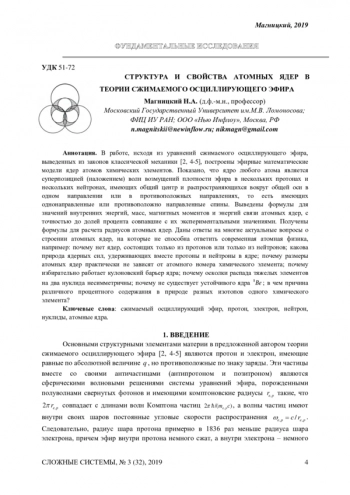В работе, исходя из уравнений сжимаемого осциллирующего эфира, выведенных из законов классической механики [2, 4-5], построены эфирные математические модели ядер атомов химических элементов. Показано, что ядро любого атома является суперпозицией (наложением) волн возмущений плотности эфира в нескольких протонах и нескольких нейтронах, имеющих общий центр и распространяющихся вокруг общей оси в одном направлении или в противоположных направлениях, то есть имеющих однонаправленные или противоположно направленные спины. Выведены формулы для значений внутренних энергий, масс, магнитных моментов и энергий связи атомных ядер, с точностью до долей процента совпавшие с их экспериментальными значениями. Получены формулы для расчета радиусов атомных ядер. Даны ответы на многие актуальные вопросы о строении атомных ядер, на которые не способна ответить современная атомная физика, например: почему нет ядер, состоящих только из протонов или только из нейтронов; какова природа ядерных сил, удерживающих вместе протоны и нейтроны в ядре; почему размеры атомных ядер практически не зависят от атомного номера химического элемента; почему избирательно работает кулоновский барьер ядра; почему осколки распада тяжелых элементов на два нуклида несимметричны; почему не существует устойчивого ядра ; в чем причина различного процентного содержания в природе разных изотопов одного химического элемента?
In the work, based on the equations of the compressible oscillating ether, derived from the laws of classical mechanics [2, 4-5], ether mathematical models of the nuclei of atoms of chemical elements were constructed. It is shown that the nucleus of any atom is a superposition of perturbation waves of ether density in several protons and several neutrons, having a common center and propagating around a common axis in one direction or in opposite directions, that is, having unidirectional or opposite spins. Formulas for the values of internal energies, masses, magnetic moments, and binding energies of atomic nuclei are derived, with an accuracy of fractions of a percent coinciding with their experimental values. Formulas for calculating the radii of atomic nuclei are obtained. Answers are given to many topical questions about the structure of atomic nuclei that modern atomic physics is not capable of answering, for example: why there are no nuclei consisting only of protons or only of neutrons; what is the nature of the nuclear forces holding together protons and neutrons in the nucleus; why the sizes of atomic nuclei practically do not depend on the atomic number of the chemical element; why the Coulomb barrier of the nucleus selectively works; why the fragments of the decomposition of transuranium elements into two nuclides are asymmetric; why there is no stable nucleus ; what is the reason for the different percentage in nature of different isotopes of the same chemical element?





